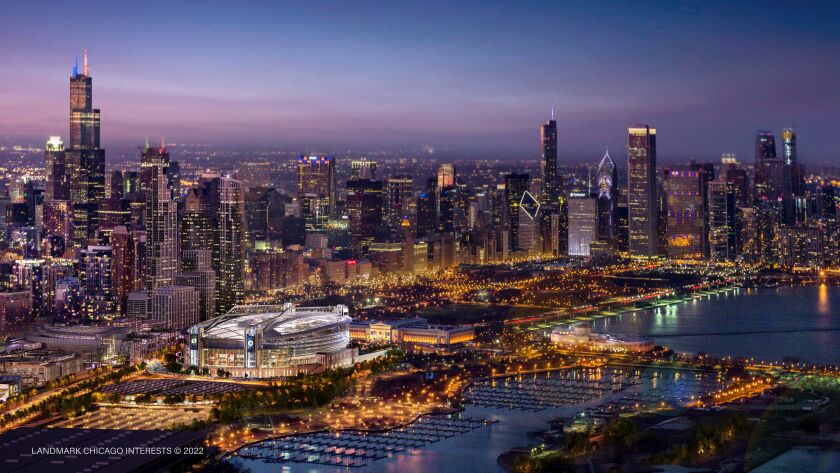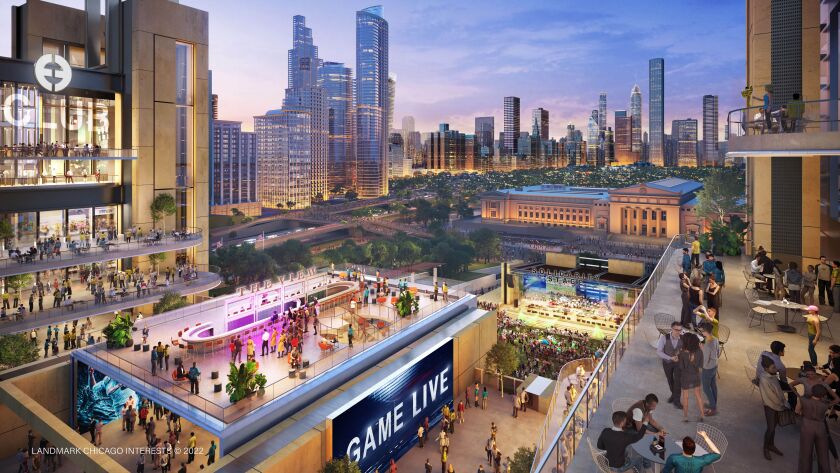Mayor Lori Lightfoot offered Monday to put a dome on Soldier Field, at a potential cost of $2.2 billion, in a desperate attempt to keep the Bears in Chicago or save face if they leave for Arlington Heights.
A portion of the cost would be paid for by selling naming rights “in a way that respects Soldier Field’s legacy as a war memorial by keeping Soldier in the name of the facility,” as the working group charged with “re-imagining” the Museum Campus suggested in its 50-page report earlier this month.
There are also sponsorship opportunities in other areas inside the stadium. If the Bears opt to stay, hundreds of millions of dollars in NFL “league financing” also could be made available. A top mayoral aide also mentioned “debt capacity.”
But key details about how the rest of the money would be raised were not revealed and must await a soon-to-be-launched feasibility study.
“Hopefully, the Bears will see that there is an overwhelmingly compelling financial case for them to stay in Chicago, particularly given the delta between making an investment here at this stadium and what the costs are in today’s dollars on building a brand new stadium from scratch. It’s not even a close call, particularly when you think about the challenges of getting financing done in this state,” Lightfoot said.
“The answer to their problems, their concerns, their desire to maximize revenue, their desire to have a Tier 1 venue [is] Soldier Field.”
The mayor refused to say how she planned to bankroll a domed and expanded Soldier Field. She didn’t rule out building the dome without the Bears, noting “plenty of cities” have had two NFL franchises.
The mayor resurrected the often-considered-and-rejected idea of a dome as one of three options for improving the stadium that reopened in 2003 after a $660 million makeover that won’t be paid off until 2032.
The other two options: preparing the lakefront stadium to receive a dome without actually building it; or, allowing the Bears to leave and proceeding with a more modest stadium renovation for the Chicago Fire, college football games, concerts and other potential uses.
Veteran stadium developer Bob Dunn described his proposal as a “hybrid” of Detroit’s Ford Field and U.S. Bank Stadium in Minneapolis.
Built on four “super columns,” the dome is “suspended above the existing structure of the stadium,” Dunn said.
Dunn acknowledged architects involved in the 2001 renovation have questioned whether Soldier Field can support a dome.
“What you could not do is rest all of that weight on this current structure. But you can build the dome above it” and enclose it, “so the building is climate-controlled 365 days a year,” he said.
“So, the answer to that question is an absolute yes. Working inside the confines of this building as we know it today, Soldier Field can transform to become a dome.”
In discussing the “dome-ready” option, Dunn said: “Given the cost of stadiums today, being able to retain over a million square feet of structure toward the redevelopment of Soldier Field has a massive cost savings relative to building a new stadium.”
Dunn described the third, multipurpose option as, in some ways, the “most interesting.”
“Depending on what the eventual tenant base is of the building, to become a soccer-first building and to meet today’s standards for professional soccer, the concept is to elevate the field 42 feet. And in doing so, you create an optimal sight line, an optimal bowl for soccer,” Dunn said.
“It also opens up the opportunity to re-program all of that area below 42 feet to the field level today to create community programming that we’ve estimated could drive upwards of 4.5 unique new visits to the museum campus on an annual basis.”
With or without the Bears, Lightfoot argued a dome could help Chicago lure marquee events like the Super Bowl and the NCAA’s Final Four.
In addition to a dome, the mayor’s plan for Soldier Field also includes:
• Increasing the NFL’s lowest seating capacity from 61,500 seats to 70,000 seats.
• Raising the number of “traditional” suites from 133 to 140.
• Adding six new “major clubs and experiential areas.”
• Creating “more flexible events space and multipurpose venues,” four of them with capacities ranging from 5,000 to 60,000 people.
• Quadrupling square footage devoted to food and beverage space — to 200,000 square feet.
• Dramatically expanding the opportunity for major sponsorships and naming rights.
“You maximize revenue, you maximize franchise value,” Dunn said, in an attempt to entice the Bears, a family-owned franchise controlled by the McCaskey family.
The Bears responded to the mayor’s offer by reiterating what they said when the 23-member working group released its report.
The team says its hands are tied by the agreement they signed to purchase the 326-acre site of the now-shuttered Arlington International Racecourse for $197.2 million.
“The only potential project the Chicago Bears are exploring for a new stadium development is Arlington Park. As part of our mutual agreement with the seller of the property, we are not pursuing alternative stadium deals or sites, including renovations to Soldier Field, while under contract,” said the statement, released July 7 and reiterated Monday.
“We have informed the City of Chicago that we intend to honor our contractual commitments as we continue our due diligence and predevelopment activities on the Arlington Heights property. In the meantime, we remain committed to fulfilling our permit operating agreement at Soldier Field.”
Juanita Irizarry, executive director of Friends of the Parks, served on the working group but was excluded from the final round of discussions on the future of Soldier Field.
Irizarry argued it makes no sense to spend hundreds of millions, if not billions, on a dome.
“We have not seen any plan that would keep that burden off the taxpayers,” Irizarry said.
“Friends of the Parks will not carry water for the mayor on this. Friends of the Parks does not agree that there should be a dome on Soldier Field. It is prohibitively expensive and there are other priorities where the city’s money should be spent.”
The money would be better spent “rebuilding or fixing crumbling fieldhouses and other park infrastructure around the city,” particularly on the long-neglected South and West sides, she said.
Irizarry also condemned as phony inclusiveness the process that Lightfoot used to get to this point.
“We all know this is the mayor’s M.O. It’s disappointing, but not surprising that the mayor would convene a small group of folks, but suggest that all of us were on board and supportive,” Irizarry said.
“There were side conversations that were not vetted through the whole group. That is not surprising. We imagined all along that there would be discomfort in participating on this committee because there would end up being things we did not agree with like this.”
Taking part in Lightfoot’s announcement was Dunn, president of Landmark Development. He’s behind a plan for a new high-rise neighborhood, One Central, that would be built over the Metra Electric tracks just west of Soldier Field. But he’s also a veteran stadium developer who has worked with several NFL teams, including all the Bears’ NFC North division rivals: Green Bay, Detroit and Minnesota.
Dunn played a key role in producing a renderings released Monday showing Soldier Field surrounded by a new structure supporting a retractable roof. A source said Dunn has volunteered ideas about what to do with Soldier Field, given his experience with NFL stadiums.
The stadium’s future is important to the One Central project, which requires an estimated $6.5 billion state subsidy for a transit hub. Dunn has said the hub is needed to support his development. One Central has gotten a frosty reception from Lightfoot and many Near South Side residents. Gov. J.B. Pritzker, who backed legislation for the transit hub, has since grown cool to the financial obligation.
One Central has not gotten city zoning approval. The transit agencies involved — CTA, Metra and Amtrak — have not committed themselves to any transit hub, although Metra has backed early construction work as long as it doesn’t impede commuter trains.
Ever since the Bears signed the agreement to purchase the old racetrack site, Lightfoot has sounded almost resigned to losing the team. With or without the Bears, however, she also has said she wants to improve Soldier Field and maximize year-round revenues.
Monday, Lightfoot struck a far more optimistic tone.
“They have some legal constraints at this moment about what they can do. But, we’re gonna keep making the case for them that it makes no sense to go anyplace else but stay in the city of Chicago,” she said.
“Clearly, we have thought about the possibility of the Bears leaving. But, I feel confident that will not have a negative economic impact on the city or, frankly, on the utilization of Soldier Field. This is a very sought-after venue. No question about it.”
Sport marketing expert Marc Ganis has advised numerous NFL teams on stadium financing.
He also told the Sun-Times earlier this month that no amount of Soldier Field improvements — he called them “lipstick on a pig” — will keep the team in city.
“Even if they achieved everything that’s been listed and they paid for it all with public funds,” Ganis said, “it wouldn’t even be close to sufficient for a future long-term home for the Bears.”
That’s because it “doesn’t change what the building is: a small, difficult-to-get-to, publicly owned and operated stadium that is not even close to being sufficient to host an NFL team in the third-largest market in the country for decades to come in a modern-day NFL that requires a large physical stadium with many areas to be programmed and team facilities.”










